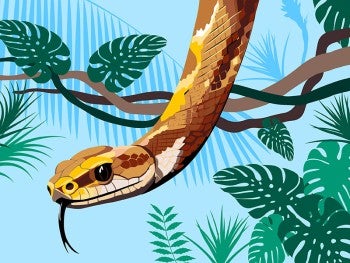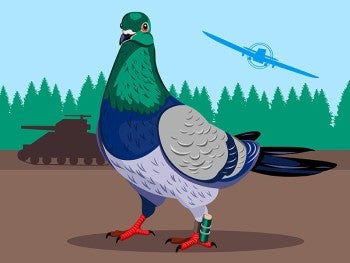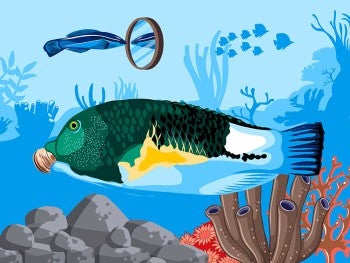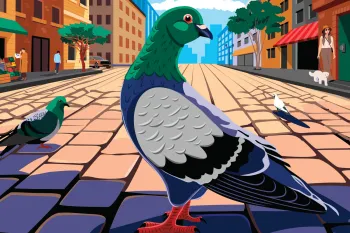In 2011, researchers set out to determine which wild animals people think are the most charismatic. After surveying over 4,500 people, they found tigers, lions, elephants and giraffes ranked highest. Of the top 20 animals, participants overwhelmingly favored larger, terrestrial mammals. The only non-mammals chosen were crocodiles and sharks.
The results aren’t exactly surprising. Although all animals have inherent value and play important roles in their ecosystems, people often don’t view all equally. Many species are seen as gross, scary, bothersome or just plain uninteresting.
While it may not seem important if certain species are more beloved than others, social attitudes can influence which animals people protect and which they kill without second thought. “The way we talk about animals decides their fate,” says John Griffin, Humane World for Animals senior director of urban wildlife programs. “That language builds up. It’s not evaluated, it’s not interrogated and we pass it on to our families and neighbors.”

Rachel Stern/Humane World for Animals
Snakes
Snakes commonly evoke visceral fear in people. They are often portrayed as villains in pop culture, and the behaviors people see as creepy—such as striking, hissing and flicking their tongues—are played up. Look at Kaa the python from The Jungle Book who hypnotizes his prey before attacking, the two serpentine villains in the Harry Potter universe or Indiana Jones’ extreme fear of the slithering reptiles. “Snake” is also used as a term to describe someone seen as sneaky. (On social media, Instagram users frequently comment with the snake emoji when they think a celebrity is being shifty.)
Snakes might seem strange, but their behaviors serve important purposes. When they flick their tongues, they are collecting chemical information from their surroundings. Their tongue is a vital tool for navigation and the forked shape lets them survey a larger area. Another “gross” thing snakes do is shed their skin. All animals (including humans!) do this; snakes just do it more noticeably, all at once.
Snakes also play an important role in their environment by keeping prey populations balanced and dispersing seeds through their excrement. Ironically, without snakes, other animals we consider “pests,” such as mice and rats, would boom in populations.
Many people are wary of snakes out of fear of being bitten. However, snakes generally try to avoid people and only bite in response to feeling threatened
or provoked. Of the more than 3,000 snake species worldwide, only 600 are venomous, and only 200 of those have venom toxic enough to kill or significantly harm a human.
Fears are understandably amplified in communities living near venomous snakes. In India, considered the snakebite capital of the world, Humane World for Animals India is working with The Liana Trust to better understand snake behavior, educate communities on safely sharing space with them, and distribute knee-length boots and flashlights so vulnerable populations can protect themselves. They’re also working with governments to help them better address human-snake conflict and treat snakebites.
“As snakes are often considered less charismatic than elephants and tigers, they receive relatively little attention in India, and citizens are generally not educated on snake safety,” says Sumanth Bindumadhav, Humane World India’s director of wildlife protection.

Rachel Stern/Humane World for Animals
Mice
Mice are often viewed as either pests, pets or subjects of medical experimentation, depending on the situation.
Scientists believe mice started living in close contact with humans around 15,000 years ago as people began to become farmers rather than hunter-gatherers. Mice found us to be good housemates, with our steady supply of food and doors to keep out predators. Many centuries later, in the 1800s, people were keeping domesticated mice as pets around the world and breeding them for different physical traits. In England, these pets were called “fancy” mice, and mouse clubs and exhibitions started to pop up.
Most people today only interact with mice when they become unwelcome visitors in human homes. There’s a whole host of cruel products—such as snap traps, poisons and glue traps—people use to kill rodents. These products not only subject mice to slow, painful deaths but also threaten pets and wild animals who encounter these traps and poisons, or eat poisoned mice.
Legislators are starting to take note. England banned glue traps in 2022 after lobbying by Humane World for Animals UK (then Humane Society International UK) and other organizations. In the U.S., a federal bill was introduced in January 2024 to end the sale of glue traps.
At the same time people are trying to remove wild mice from their homes, others actively bring pet mice in. Due to their high reproductive rates, mice are often available for adoption at shelters and rescues. Pet mice can be affectionate companions and are incredibly clean due to their meticulous grooming habits. Mother mice are also doting parents to their pups, who are born unable to move, maintain body heat, see or hear. Father mice aren’t much help, but the mothers look out for one another. Multiple mothers will raise their young together in a communal nest, and mothers will even nurse pups who are not their own.
Dave Pauli, our former wildlife conflict resolution program manager, has had deer mice living on his Montana property for years. Rather than try to remove them, he cherishes his wild neighbors and fondly remembers one deer mouse he named Gerty. Pauli’s neighbors knew he was a wildlife rehabilitator and on multiple occasions gave Pauli abandoned baby mice they found. Pauli put the babies by Gerty and each time she would take them into her den and raise them as her own. Pauli says one of Gerty’s great, great, great granddaughters currently lives in his yard.

Rachel Stern/Humane World for Animals
Pigeons
Talk about pigeons and inevitably you’ll hear them called “rats with wings,” a phrase that illustrates people’s disdain for two separate animals in three short words. Pigeons and rats are both seen as “dirty” and “disease-ridden,” and their presence is considered a sign that a city itself is dirty. Although pigeons can carry diseases that are transmissible to humans, so do many other animals, says Griffin. And the risk of disease transmission from pigeons to humans is very low, he adds.
Pigeons weren’t always seen this way. They were domesticated around 5,000 years ago and have lived in close contact with humans as pets, food sources and messengers. They were even used to deliver military communications during World Wars I and II (multiple pigeons received military awards for their work). Pigeon-keeping became less common in the mid-20th century as factory farming grew and we developed new ways of communicating, and many people likely abandoned their animals.
The pigeons we see today in towns and cities are actually the feral ancestors of the animals we once relied on and cared for. As cliff-dwelling animals, they learned to adapt to city life by using our buildings as artificial cliffs.
In manageable numbers, pigeons can be delightful neighborhood regulars. Many pigeons have velvety, jewel hues of green and purple around their necks and gently coo to each other. Far from being “bird-brained,” pigeons are skilled navigators who can find their way home from hundreds of miles away and live in groups where they determine social order based on size. (Researchers found that if they placed tiny, weighted backpacks on pigeons, the birds climbed up the social ladder. When the backpacks were removed, the pigeons went back down in status.)
When conflicts with pigeons occur, our Wild Neighbors team works with governments to implement humane solutions such as taking away desirable flat surfaces pigeons use for nesting. City managers can also use specialized pigeon birth control feed to stop reproduction.
Heidi Prescott, Humane World for Animals’ vice president of companion animals, has had a close connection to pigeons for decades. In 1989, when she was working with the Fund for Animals, she learned about live pigeon-shooting competitions in Pennsylvania and visited these events firsthand. “It was probably one of the most horrific things I’ve ever seen,” she says.
Live pigeons (captured with nets in places like New York City and brought to these events) are catapulted into the air and participants compete to shoot the most birds. As a wildlife rehabilitator, Prescott would search for wounded birds after the events. One time she found a female pigeon who had her legs blown off. The pigeon was gasping for breath and had blood coming out of her mouth. As Prescott humanely euthanized the bird, she promised to fight until pigeon shoots were banned.
Thirty years later, Prescott is still fighting. Pennsylvania is the only state where pigeon shoots still regularly occur, but they occasionally pop up in other states. In recent years, Prescott has seen growing support among legislators to end these contests. Still, “if it was a kitten shoot, we would have stopped it in like a minute,” she says. “But because it’s pigeons, it’s far more challenging.”

Rachel Stern/Humane World for Animals
Fish
The term “fish” encompasses an estimated 32,000 species—greater than the total number of amphibian, reptile, bird and mammal species combined. Many of the common fish species people find in grocery and pet stores are often viewed as mindless animals without the capacity to feel pain. There’s even a widely and falsely held belief that fish only have a 3-second memory.
Paul Petersan, a senior analyst and strategist with the Humane World for Animals farm animal protection team, thinks people underestimate fish intelligence because we rarely see them interacting with their natural environments. Researchers who have looked below the water’s surface have made astonishing discoveries that only begin to shed light into the lives of fish.
Back in 2001, researchers found that rainbow fish not only learned how to navigate through a net with a hole in it but seemed to remember how to escape when the net was brought back a year later. Fish have been documented using tools; a black spot tuskfish was once seen using a rock to help open a shell. And despite antiquated beliefs that fish do not feel pain, researchers found that they do indeed sense pain, they just respond differently than terrestrial animals.
Perhaps most remarkably, multiple studies found that the cleaner wrasse—a small fish found in coral reefs—passed the mirror self-recognition test, considered the gold standard in testing animal cognition. The results were met with skepticism in the scientific community, which fish researcher Culum Brown attributes to negative societal views of fish.
“The gap between public perception of fish intelligence and scientific reality has serious implications for our interactions with fishes,” Brown said in a 2019 paper in Animal Studies Journal. Although it’s difficult to calculate the exact number of fish we use each year, the estimates we do have are massive.
Annually, around 2 billion ornamental fish are traded globally to be pets, up to 2.2 trillion are fished from the wild and up to 124 billion farmed fish are killed for food. Fish are believed to be the second most commonly used animals in U.S. laboratories, but the exact number is unknown because they are not covered under the federal Animal Welfare Act.
Take action
To help mice, snakes and other animals, ask your legislators to support bans on glue traps. And if you live in Pennsylvania, urge your state representative and senator to support the end of live pigeon shoots.

